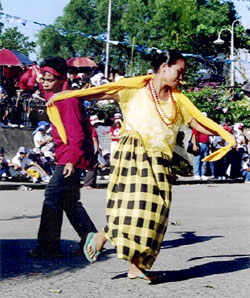The view from within Lambunao

Lambunao to most Ilonggos meant the 24,692-hectare, third-class town located at the northwest part of Iloilo Province. The town is bounded by Calinog in the north, in the east by Dueñas and Pototan in the south by Janiuay and Badiangan and in the west by Iloilo City and Valderama of the Province of Antique. With its 73 barangays, the town, known by what was, for many years as one of nature's paradise, with view from within the area is nothing short of awe-inspiring.
In time, having become the land of waterfalls, Labunao got its name from the phrase "Nagapanglambu sa linao" or "fishing by the lake" when sometime in 18th century, a Spanish soldier approached a native and asked what he was doing. Politically, the town was an arrabal of Janiuay and was under the parish of Dueñas. However, with the construction of an all-weather national road in 1912, linking the province of Iloilo to the province of Capiz passing through Lambunao, it attained its independent status being politically separated from Janiuay.
For those who want to experience a real get-away, far from the noise and the congestion of crowds, Lambunao is one ideal place. A good 45-minuter shuttle service or an hour jeepney ride away from the city will lead you to view lushy green mountains made even more scenic with its quite rural setting.
With its wealth of unending spectacles to behold and enjoy, Lambunao's reputation as one of the provinces' nature's paradise has made people forget the rich history that the town has. With 22 documented pristine waterfalls, virgin forests, rare flora and fauna---these are but some of the sights in the municipality. It's a good thing Lambunaonons, with the support of their very dynamic Municipal Mayor, Hon. IGNACIO L. RAMIREZ, JR., are taking efforts to protect, maintain and package the municipality as one of Iloilo's must-see destinations.
Lambunao has always excited its visitors, with its various wildlife species at the WVSU WILDLIFE CONSERVATION PARK located at West Visayas State University College of Agriculture and Forestry at Barangay Jayubo. Inhabitants claim that there are a number of endangered species found in the Center. Popular are the exotic birds Dolongan and Tarictic Hornbill. Endangered species like cloud rats and spotted deers have gained national exposure when it was once featured in ABS-CBN's Magandang Gabi Bayan. The site is also known for its 100-hectare coffee and 10-hectare durian plantations.
A three-hectare lake, about 80 meters deep situated in the mountain village of Cabatangan is an aquatic haven for its freshwater eel, carp and tilapia. Nestled at the foot of Mount Apog-Apog from the Iloilo-Antique border, TINAGONG DAGAT is a freshwater lake that is a 10-hour hike from Barangay Jayubo---the last barangay that can be reached by vehicle. Its adjacent forest which houses monkeys, wild pigs and serpent eagles is rich with trees that reach dizzying heights, with ferns and orchids, providing a refreshing breeze of air under its shades making the destination all the more inviting for campers.
Lambunao is an ideal site to the provinces' most interesting waterfalls. With an elevation of 30 feet, dropping 2,000 gallons of water per minute to a 500-square basin with a depth of 20-30 feet, MAASIN Waterfalls is just one of the municipality's falls and is considered as the most famous in he province.
After its presentation during the 1st Tumandok Festival in September and Ilonggo Dance Festival in October, the Binanog Dance is all set to perform in a competition. With the town's very active Tourism Officer Jennifer Osorio as Festival Chairman, seven (7) tribes have been designated as official performers on January 8, 2006 at 8 a.m. at the Lambunao Municipal Plaza. Like the rest of festivals in the province, the municipality has prepared for the upcoming event and has uniformly conceptualized its festival format. The BINANOG FESTIVAL with the theme: "Binanog Dungog kag Manggad Halad kay Señor Sto. Niño," is a week-long celebration wherein guests can start the festival first day on January 3, 2006 with various activities such as food festival featuring delicious Lambunao specialties, a fun-filled night as people jive with invited bands as they belt out their repertoire and various events competition set by the committee. Based on the courtship of two banog birds, the festival dance is a living testimony to the natural artistry of Lambunaonons, the beauty of traditional Lambunao culture and the intrinsic hospitality for which they are known.
The views from within Lambunao ranges from the green mountains rising above the town to the poblacion with its landmark --- the St. Nicolas de Tolentino Parish established in 1880 with its pinkish facade and the serene blue waters of its falls. Indeed, Lambunao provides an ideal venue for communing with nature in all its splendor.
